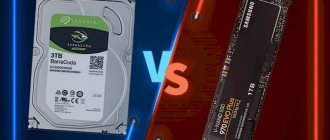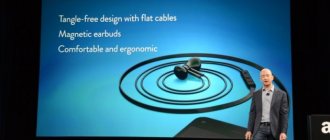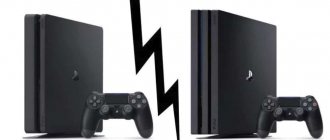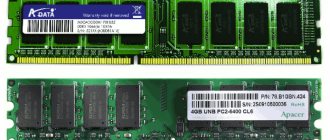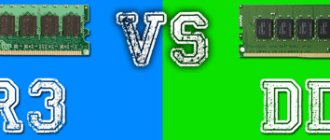1
Intel SSDMCEAC240B301
Look
2
Samsung MZ-V7E1T0BW
Look
3
Plextor PX-512M6M
Look
Literally from the moment the first computers appeared, almost immediately the world began a serious struggle to increase the volume of memory storage media, which are hard drives. Just ten years ago, not a single user could imagine that a hard drive with 1TB of memory could exist. These days, these are not the parameters of the latest computer or laptop.
But modern technologies do not stand still and progress in the field of data storage is visible even to the naked eye. Confirmation of the high level of computer technology are SSD drives (solid-state drives), which replaced outdated HDD drives. An SSD drive is a flash memory-based device that visually resembles an ordinary microcircuit.
Main advantages of solid state drives
Every person who has encountered a laptop or computer at least once in their life knows how noisy a working HDD drive is. This haunting, incessant sound is caused by the hard drive spinning at 100 revolutions per second. Using an SSD makes your laptop run silently. This is because a solid state drive has no moving parts. Plus, these data storages do not heat up at all, which is also a serious advantage.
The main advantage of an SSD is its highest operating speed, which significantly increases the performance of a laptop. Solid state drives further increase the speed of data processing, since accessing information on an SSD is many times faster than on a HDD. Let's take a simple example: a standard hard drive operates at a speed of 70-100 MB/s, while the speed of an SSD can reach 500 MB/s without any problems, which is also not the final limit.
The advantages of SSD drives listed above are not the only ones; they also include:
- significant impact resistance, several times greater than the durability of rather fragile HDDs;
- relatively light weight and solid compactness, which is of paramount importance for laptops whose size is limited in size;
- minimum level of energy consumption.
Best SSDs for professional or server PCs
Such computers are constantly working, and they have to deal with complex and resource-intensive programs that are often updated and changed. As a result, SSD drives are needed here not only fast, but also as large as possible, and also with the maximum number of rewrite cycles.
Intel SSDPE2KE076T801 – product for servers
5.0
★★★★★
editorial assessment
100%
buyers recommend this product
Intel's SSD is a real monster with a capacity of 7.6 TB. Despite this, the disk form factor is standard, if not the most popular (2.5″). But the main feature of the model is the data exchange speed exceeding 3 GB/s, thanks to the connection via the PCI-E 3.1 interface. At these speeds, Windows boots in just a couple of seconds. True, such power also requires increased power supply (up to 15 W), so when assembling the machine, take this into account.
Pros:
- The volume is prohibitively large for a solid body.
- Highest operating speed.
- 3D Nand cells.
- Availability of smart and encryption programs.
- Does not heat up above 55 degrees.
- Compact sizes.
Minuses:
- Price over 230 thousand.
Everything about an Intel SSD is perfect. The fastest possible work, huge volume and even its standard sizes, which will allow you to save money on the purchase of a mega-case.
Micron MTFDDAK1T9TDN-1AT1ZAB – for professional PC
4.8
★★★★★
editorial assessment
88%
buyers recommend this product
An excellent SSD for a powerful PC has huge capacity and 3D Nand cells, which will allow you to use it for a long time. The drive is quite easy to connect and is switched via the SATA interface. Its operating speed exceeds 500 MB/s, which will allow powerful programs to work as quickly as possible, and most importantly, stably.
Pros:
- Stable and fast work.
- Large memory block.
- Easy to install.
- Availability of native drivers.
- Long lasting cells.
- High build quality.
Minuses:
- The price is almost 36 thousand.
- Fast heating.
Despite its shortcomings, one of which can be solved simply by adding an extra fan to the case, Micron is one of the best SSDs for a professional PC.
Significant disadvantages of SSDs
Despite significant operational advantages, new drives are not without certain disadvantages, the first of which is their higher cost compared to standard hard drives. The average price of such a device will cost the owner of a laptop no less than 4,000 - 5,000 rubles.
The second obvious disadvantage is the wear and tear of the SSD. Let's confirm this information using an example. Thus, the most ordinary solid-state drive in reality provides no more than 10 - 12 thousand information processing cycles. At the same time, other disks developed on the basis of MLC technologies are capable of processing 8 - 10 times more information over the same 4 - 5 years.
Such technologies will be replaced by new, more advanced ones, which will include FRAM and RAM-SSD, on the basis of which solid-state drives will be able to operate continuously for 35 - 40 years.
Another serious drawback should be considered vulnerability to voltage surges, which can destroy any SSD with significant surges.
And the last disadvantage of solid-state drives is the inability to restore information in the event of its sudden loss. The fact is that at this point in time there are no programs that make it possible to recreate the data that was on the drive when the flash drive failed. This is due to the fact that with a strong voltage surge, the entire board burns out. At the same time, there is a way in which the problem can be easily resolved. In order to avoid such a situation with flash memory failure, it is necessary to use an uninterruptible power supply.
Thus, with all the advantages of using SSD drives, there are also some disadvantages, which, however, can be corrected without any problems.
Fragmentation
The favorite “delicacy” of any HDD hard drive is large files: movies in MKV format, large archives and BlueRay disk images. But as soon as you load the hard drive with a hundred or two small files, photographs or MP3 songs, the reading head and metal pancakes become confused, as a result of which the recording speed drops significantly.
After the HDD fills up and files are repeatedly deleted/copied, the hard drive starts to work slower. This is due to the fact that parts of the file are scattered across the entire surface of the magnetic disk and when you double-click on a file, the reading head is forced to look for these fragments from different sectors. This is how time is wasted. This phenomenon is called fragmentation , and as a preventative measure to speed up the HDD, a software and hardware process is provided for defragmentation or organizing such blocks/parts of files into a single chain.
It is recommended to perform defragmentation periodically on all types of HDD drives, thereby maintaining their optimal speed.
The operating principle of an SSD is fundamentally different from a HDD, and any data can be written to any memory sector with further instant reading. This is why defragmentation is not needed for SSD drives.
Choosing an SSD: what to look for
There are plenty of reasons to use SSDs today - immunity to vibration and shock, performance, and low energy consumption. For a long time, the main barrier to switching to such drives was the significant cost, which these days has dropped significantly, so that SSDs can be used for everyday work without worrying about your data at all.
It is clear that you should choose a solid-state drive for a reason, but based on the main criteria for evaluating flash memory. Let's list what you need to focus on when choosing an SSD:
- Bus and its capacity. This factor is responsible for the speed of reading and transmitting information data. The higher it is, the better. We should not forget about the speed limits of the bus installed on the PC or laptop.
- The form factor of the solid-state drive, which is responsible for the size and dimensions. This evaluation criterion is necessary, first of all, for laptop owners, since the space in its case is very limited.
- Memory size. Typically, solid-state drives are used to host the operating system, which is why the speed of a laptop or computer increases rapidly. These indicators are a serious argument for SSD in comparison with a regular HDD.
- Controller. It is a mandatory part of any SSD drive. Responsible for the uninterrupted operation of the drive and also distributes information data. Most users prefer time-tested controllers produced by popular brands such as Samsung, Intel, etc.
- Flash memory type. Flash memory chips used for SSD drives have specific features for storing information.
At the moment there are 3 types: SLC, MLC and TLC:
- SLC - drives based on this technology are characterized by high-speed reading and writing of information, excellent performance and minimal power consumption. Such SSDs are usually used on the most popular servers.
- MLC - in comparison with SLC, they have significantly lower performance and number of operating cycles, but they cost incomparably less. Due to their acceptable price/quality ratio, such drives are very popular in the commercial sphere.
- TLCs are highly dense due to three levels of information data storage segments, which reduces the speed of information processing and reduces productivity. The lowest indicators are also in terms of the number of operating cycles, if we take SLC and MLC as a comparison.
It is thanks to these criteria that you can confidently choose a solid-state drive that is ideal for your laptop.
As practice shows, the best option is to use an SSD paired with a standard HDD, where the flash memory will be used to install the OS, while the hard drive will be able to store all the remaining information.
How to choose an SSD for a laptop
It is logical that every user with at least a little knowledge of computer technology wants only the best SSD for a laptop.
Modern manufacturers offer a serious selection of solid-state drives, each of which has its own advantages and certain disadvantages. Here is a list of the best SSD drives today.
Installing an SSD in a laptop - options and pitfalls
Now it’s worth talking about some nuances. Now I can’t say for sure, but since 2005, almost all laptops have had a SATA interface for connecting a hard drive - the easiest way is to replace them with an SSD (just open and change them). Hard drives for laptops (form factor 2.5) had two standard thicknesses (9.5 and 7 mm), so try to choose a 7mm SSD drive (I haven’t seen others, but just in case) - after all, 7mm will definitely fit instead of 9mm... and on the contrary, nothing will work!
Currently, the M.2 connector is gaining popularity (including on classic computers) - they can also work using the SATA or NVME protocol. Visually, they may be practically the same - so it’s worth reading the documentation for your laptop to find out what type of SSD it supports (and it happens that you can plug both an NVME and a SATA drive into one connector... of course, not at the same time)
So... let's sum it up! We found out that SSDs come in several form factors:
- SATA 2.5 SSD
- M.2 SSD (SATA or NVME)
We take the required SSD and get ready to replace it!
Installing an SSD in a laptop instead of an old HDD
What will you need? A bright head, the SSD itself and a screwdriver (usually a small Phillips head)… and it wouldn’t hurt to prepare an external HDD for copying data
Before you start disassembling your laptop, I highly recommend taking a look at Youtube and searching for your laptop model to see how you will have to get to the installed HDD. For some laptops this is easy, but in some models you may have to go through half the device to get to the drive.
We simply replace the HDD with a purchased SSD and can reinstall the system (or transfer the existing one to a new drive... but I recommend doing a clean installation!)
What to do with an old HDD
If you have forgotten when you used a DVD drive, then your best option would be to install the old HDD in the optical drive bay. The cost of this thing (called optibay) is about 200 rubles on Aliexpress (if you don’t know how to order there, read the note about the Aliexpress online store) ... however, there are some nuances here, just like with HDD. Laptops use standard and slim (thin) drives - therefore optibay must be of a certain size... there are 9.5 and 12.7 mm thick - don’t go wrong when buying!
Why HDD in optibay and not SSD? - a logical question! The first thing that comes to mind is performance... the reason why we take an SSD can be offset by the low throughput of the drive in such an adapter. Well, not every laptop can start correctly with an SSD in the DVD bay.
Will this ruin the appearance of the laptop? — this will have absolutely no effect on the appearance of the device! All drives in laptops are standard, so the external socket is removed from the old DVD and transferred to Optibay - you will even have the button to open the drive... but it will no longer be of any use!
And finally, you can make an external hard drive from your old HDD and use it as a huge flash drive. There are still people who need a DVD drive and under no circumstances should they occupy it. This gadget costs about 500 rubles and does not require any special skills - insert it and it works!
As you can see, you can always find somewhere to put an old HDD - there are no problems with that...
What to do with the operating system?
Ideally, of course, reinstalling a clean OS from scratch - fortunately it takes very little time. However, there are utilities for migrating to an SSD without losing data - but this topic is quite extensive and would take up a whole series of notes, so I don’t see the point of discussing it here.
If there's room for M.2
If your laptop is equipped with an m.2 connector, then you are lucky - you just buy a drive of the required volume and standard size (usually 2280 - where the first two digits are the width, and the second two are the length). Well, the subsequent reinstallation of the system or cloning from your old HDD. The undoubted advantage is that the old HDD will remain in the laptop and there is no need to purchase any additional devices (and the DVD drive will not have to be removed from the system).
Intel SSDMCEAC240B301
The production of this SSD is directly related to the use of the latest technologies, which guarantee the laptop owner excellent performance, high information processing speed, durability and characteristic quiet operation.
Intel SSDMCEAC240B301 works several times faster than any hard drive, is perfectly protected from shocks and various types of vibrations, as a result of which the SSD has a long service life even in the event of falls and strong shaking.
The improved SandForce SF-2281 controller allows you to record and read video, open software, as well as documents at a speed of 520/550 Mb/s. The disk capacity is 240 GB, which is more than enough to complete the assigned tasks.
Advantages of this SSD:
- huge lifespan between failures - 1,200,000 hours;
- connectable SATA6Gbit/s interface without any problems;
- the cost is within 17 thousand rubles.
Samsung MZ-V7E1T0BW
The Samsung MZ-V7E1T0BW solid-state drive has a memory capacity of 1TB, so the laptop owner can now store an almost unlimited amount of information on the disk. The trouble-free operation of this SSD is guaranteed for at least 5 years.
In terms of read and write speed, this drive surpasses most existing analogues, amounting to 3400/2500 MB/s.
The SSD uses the latest five-core Samsung Phoenix controller, where one core is needed to communicate between the controller and the host system.
Among the characteristic advantages of Samsung MZ-V7E1T0BW:
- fantastic speed of reading and writing data;
- excellent speed of completing tasks;
- long-term operation without breakdowns.
If we talk about the disadvantages of the model, it is worth noting its high cost, reaching in some cases up to 19,000 rubles.
The best SSDs for a gaming computer
Gaming machines require good hardware, including a high-speed SSD. There is no point in overclocking a simple toy, but a serious one will require a lot of free memory. That is why a gaming SSD must not only be fast, but also have a sufficiently large capacity.
Samsung MZ-76Q1T0BW – flawless as always
5.0
★★★★★
editorial assessment
100%
buyers recommend this product
1 TB of memory with 3D Nand cells will allow you to use this solid-state drive no worse than a regular HDD. At the same time, the disk has the most popular form factor and is connected via the SAT interface, so there will be no problems with installation. The quality of assembly and materials is also beyond doubt, and the operating speed (550 and 520 Mb/s), in fact, is limited only by the capabilities of the PC interface. At the same time, the Samsung drive looks stylish and will decorate any PC with a transparent case.
Pros:
- Large volume.
- High speed.
- Stylish design.
- Impeccable quality.
- Cool memory cells.
- Availability of native drivers.
Minuses:
- The price is more than 8 thousand.
- Requires 6 W of power.
Large memory capacity combined with long-lasting cells and high speed make this the #1 SSD on the market.
Transcend TS1TMTS830S – good for overclocking games
4.9
★★★★★
editorial assessment
100%
buyers recommend this product
Specifically designed for gaming PCs and laptops, this SSD features long-lasting cells that allow you to change games frequently without worrying about running out of memory. Moreover, Transcend offers its owner a whole terabyte - for an SSD this is really a lot.
The drive is connected via the SATA port, but it is also possible to communicate via M2, if your motherboard has one. At the same time, the average read and write speed of the drive exceeds 530 MB/s, and the number of operations per second reaches 85,000 IOPS.
Pros:
- Doesn't heat up.
- Presented in the form of a plank and does not take up much space.
- Easy to connect.
- High speed.
- Large amount of memory.
Minuses:
- The cost is more than 9 thousand.
- Lack of drivers to install.
Excellent SSD – high speed and large capacity. With it, games will run at maximum speed.
SanDisk SDSSDA-1T00-G26 – suitable for online battles
4.8
★★★★★
editorial assessment
90%
buyers recommend this product
Another terabyte gaming SSD designed for computers and laptops, which shows high operating speed. During installation, you will have a choice: whether to place the solid-state drive near the rest of the hard drives or send it to the motherboard - both the dimensions and the available connection methods allow this. By the way, the second option is preferable, since there the powerful disk will receive its share of cooling. Unfortunately, MLC cells will not allow you to change games too often, limiting yourself to the online versions. But a couple of your favorite ones can be filed away.
Pros:
- Easy to install.
- No overheating problems.
- Large memory capacity (1 TB).
- Compact sizes.
- Installation variability.
Minuses:
- Lack of accelerating and stabilizing programs.
- Limited number of rewrite cycles.
SanDisk is a good, fast, silent and large SSD that will allow you to support your favorite games and play them at maximum settings.
READ ALSO
12 Best Portable Hard Drives
Plextor PX-512M6M
SSD Plextor PX-512M6M has a good memory capacity of 512 GB. The controller provides Marvell 88SS9188, write/read speeds of 440/520 MB/s.
The advantages of this solid state drive include:
- decent resource;
- ensuring moderate temperatures in the case of normal ventilation of the housing;
- acceptable data writing/reading speed.
Kingston SA1000M8/480G
The Kingston SA1000M8/480G drive with a memory capacity of 480 GB has the ability to store and process a significant amount of information data. It is worth saying that this SSD can be perfectly used not only in laptops, but also on desktop computers. The write and read speed is excellent, amounting to 900/1500 MB/s.
The work is controlled by the Phison PS5008-E8 controller, which also copes without problems with compressing data that is written to memory. The manufacturer's warranty period is 5 years, so the SSD should serve you faithfully for a long period of time.
SSD vs HDD: what to buy and what's the difference
Reward accrued
This news was written by a site visitor and a reward was awarded for it.
Many of our readers believe that SSDs are superior to traditional hard drives in all respects. In some ways they are right, but there are also characteristics in which all modern SSDs are still far from the good old hard drives.
Price . This is the main reason why people still choose hard drives. 1GB of data on inexpensive SSDs costs around $0.10, while a GB of HDD data starts at $0.02. Despite this, huge amounts of data are no longer relevant and are required only by large hosting and servers.
announcements and advertising
2080 Super Gigabyte Gaming OC for 60 rubles.
Compeo.ru - the right comp store without any tricks
RTX 2060 becomes cheaper before the arrival of 3xxx
Ryzen 4000
series included in computers already in Citylink
The price of MSI RTX 2070 has collapsed after the announcement of RTX 3xxx
Core i9 10 series is half the price of the same 9 series
The price of memory has been halved in Regard - it’s more expensive everywhere
Productivity . For this indicator, no hard drive can compare with a solid-state drive. Most consumer hard drives can handle around 300-1000 input/output operations per second (IOPS) at best, while SSDs can handle up to 500,000. While SSD speeds are constantly increasing, HDDs are no longer capable of progressing.
Reliability . In addition to better performance, SSDs are much more reliable and less likely to fail than HDDs. Another characteristic in which SSDs are ahead is endurance when dropped. Even if the hard drive does not break if it falls, it will not be possible to read information from it. The SSD will simply continue to function. Well, the temperature: SSDs are not only more durable, but many of them have a smart controller that saves them from overheating.
Lifespan . Everything is simple here: an SSD is capable of digesting 200-600 TB of data, while a regular hard drive is at best up to 150 TB.
Noise and vibration . As soon as you get rid of a slow hard drive, you immediately start missing something, and only over time do you get used to the silence. SSDs are truly silent.
Energy consumption . According to experts, after replacing your old hard drive with an SSD, your operating time can increase by 30-45 minutes.
Volume . Traditional hard drives are leading in this area. There are examples of SSDs with simply enormous capacity, but they all cost a lot of money and act solely as examples of what technology will look like in the future.
Service . How often have you had to defragment? Modern SSDs do not require maintenance. They just work and do it perfectly. More information here.
ADATA XPG SX6000 Pro 512GB
The ADATA XPG SX6000 Pro 512GB drive with a memory capacity of 512 GB is based on the Realtek RTS5763DL controller. This unique model is not the first collaboration between ADATA and Realtek, which indicates the production of only the best models.
The write/read speed is quite good, it is 1500 MB/s and 2100 MB/s, respectively. The manufacturer's warranty for SSDs is 5 years, so the drive can last for a long time without breakdowns.
The advantages of this model include:
- excellent speed, especially with proper space distribution;
- inexpensive;
- stock by appointment.
The only drawback of the ADATA XPG SX6000 Pro 512GB is the noticeable heating of the controller during active use.
Crucial CT500MX500SSD4
This SSD is distinguished by a new modification of the Marvel controller and the simultaneous use of flash memory with the ONFI 2.2 interface.
The speed of writing and reading data is quite good, amounting to 510 and 560 MB/s, respectively.
The memory capacity is 500 GB, so you can store a sufficient amount of information on it.
Pros of Crucial CT500MX500SSD4 SSD:
- quiet operation;
- easy installation even on a laptop;
- long service life - from 2 to 5 years.
If we talk about the disadvantages of this model, then it is worth mentioning the insufficient reliability of this solid-state drive.
Western Digital WD BLUE 3D NAND SATA SSD 500 GB (WDS500G2B0B)
SSD Western Digital WD BLUE 3D with a memory capacity of 500 GB is based on the Marvell 88SS1074 controller. It stands out for its stable speed of both reading and writing. In this model it is equal to 530 and 560 Mb/s, respectively.
This model is distinguished by a very reasonable price, allowing it to satisfy the needs of the mass consumer, which, in fact, is what the manufacturer sought.
Does it make sense to buy an SSD?!
To give an accurate answer to this, you first need to decide what the user wants to get from the purchase?!
Amount of information. What makes the topic especially relevant is the fact that now, for the price of a solid-state drive with a capacity of 240-260 Gigabytes, you can buy a regular hard drive with a capacity of 1-2 Terabytes. But is such a volume needed for a computer or laptop now? For an office PC, where work is mainly done with documents and projects, and everything important is stored on network drives, Terabytes are not needed in principle. Speed is more important there.
For home use, they usually buy two devices at once: an SSD drive to use as a system drive, and a separate large-capacity hard drive for file storage. Instead of the latter, removable external hard drives connected via USB are now often used. This option is especially relevant for a laptop. And if we take into account that the era of cloud storage has arrived, then there is simply no point in storing such volumes of information on your PC or laptop.
Speed of working with data. Now let's talk about speed separately. By using a solid-state drive, your laptop or computer will load the operating system in a few seconds, launch programs and applications much faster, saving files and projects will be done instantly!
SSD for games. But don’t expect that using an SSD drive will make games “fly”, as many novice users think. Using it will not increase the number of FPS in the game and the quality of graphics will not improve. He is not able to influence this in any way! Network games will not speed up either, since the speed there depends mainly on the Internet access channel. But cached files and data stored locally will be loaded much faster.
Reliability . Some time ago, solid state machines were considered unreliable and there was information that they quickly failed, literally just out of their warranty period. Now the situation has changed for the better! Failures of SSD drives occur much less frequently than failures of conventional hard drives. But the nature of these failures is much more insidious due to the fact that the SSD has a much higher number of uncorrectable errors and the data is practically impossible to recover in the future. By the way, these errors practically do not depend on the number of read and write cycles, which used to scare users. In practice, I have never yet encountered a disk that has run out of cycles. So we can assume that they are quite reliable.
Summary
So, if you haven’t yet decided whether to buy an SSD or not, then my verdict is clear - it’s worth it. These devices are fast and reliable, and the capacity of 240-520 GB is, in principle, enough for any task. Yes, it’s a little expensive, but it’s impressive! They are the future. The era of ordinary hard drives is gradually passing and the day is not far off when they will simply stop being made!
Transcend TS256GMTS800S
The Transcend TS256GMTS800S SSD has a memory capacity of 256 GB and is capable of processing a significant amount of information with read/write speeds of 450/570 MB/s. Control is carried out using the Transcend TS6500 controller (Silicon Motion SM2246EN), which supports all the necessary technologies: TRIM, NCQ, SMART and others.
The controller does not overheat during operation, which makes it fully compliant with operating conditions. The excellent quality of this SSD drive was noted not only by specialists, but also by many ordinary users.
Which SSD drive is better to buy?
All the best external SSD drives of 2020 presented in the rating have both strengths and minor shortcomings. Thanks to real reviews and test results, the process of choosing what to buy for a laptop or personal computer has been significantly simplified. Based on the results of the comparative analysis, the following proposals were identified:
- Best value for money – Gigabyte GP-GSTFS31240GNTD;
- The fastest hard drive is Corsair Force Series MP600 1TB;
- Modern technologies, stable performance – Intel SSDPED1D280GAX1;
- Best Budget Deal of 2020 – Crucial CT480BX500SSD1;
- The people's choice, the most popular brand is Kingston SUV500/240G.
In order not to make a mistake with the choice, pay attention to the brand’s reputation, the key evaluation criteria described earlier, reviews from specialists and users, and the list of supported useful technologies. They are also selected taking into account their own goals and the characteristics of the device to which the purchased product will be connected.
GIGABYTE M.2 PCIe SSD 256GB (GP-GSM2NE8256GNTD)
The GIGABYTE M.2 PCIe SSD 256GB offers an excellent balance of performance and energy efficiency. It has a good amount of memory of 256 GB, which ensures excellent operation with high speed of processing information data. The provided write and read speeds are 500 and 1100 MB/s.
The advantages of this solid-state drive include not only ample opportunities for high-quality information processing and quiet operation, but also a very affordable price, which distinguishes this SSD from many analogues.
Silicon Power M.2 2280 M55 240GB
The Silicon Power M.2 2280 M55 240GB SSD drive has excellent linear operation speeds. This drive is based on the Phison PS3111-S11 controller, which allows you to process data at read/write speeds of 560/530 MB/s.
Judging by the test results, the Silicon Power M.2 2280 M55 showed that this solid-state drive is in no way inferior to the best samples, surpassing many of them in performance.
Pros and cons of SSD and HDD
The fact is that HDD has a number of disadvantages compared to SSD:
- The average laptop drive is heavier than a similar SSD;
- it is extremely unstable to falls and shaking;
- its read/write speed is lower;
- has high power consumption.
As a rule, it is because of them that many decide to replace them, while one cannot ignore the advantages of hard drives over solid-state drives:
- Volume. At the moment, ordinary users have access to from 320 GB to 10 TB. And the same SSDs in regular stores can be found with a maximum capacity of 2TB. We are not talking about drives for industrial or server equipment, but only about those that can be bought at the nearest computer market.
- Price. For hard drives it is much lower. If you compare the cost of a popular 2 TB hard drive with an SSD of the same capacity, it turns out that a solid-state drive is 16 times more expensive than an HDD.
- With SSD, it is almost impossible to recover deleted data due to the storage method. The maximum that can be done is to take the drive to a laboratory where the necessary equipment will be available.
Based on the above, we can conclude that if the speed and security of data is more important than its volume. Do you value low power consumption? You can safely switch to an SSD drive.
conclusions
Today, manufacturers produce a sufficient number of SSD drives for laptops and desktop PCs, each of which has its own pros and cons. Choosing the best one is quite difficult, so when choosing, you should rely on reviews from other users, as well as the characteristics of a particular SSD.
Of course, some models may scare away potential users with their high prices, but looking at the huge advantages of using an SSD, you can save up the money once and purchase the option you like. Moreover, you should not expect a collapse in prices for this product.
Rating of SSD drives
Almost every company presented in the review offers a large selection of SSD drives. To determine the best nominees, experts studied numerous user reviews, opinions of experts and computer technicians. The comparative analysis was also based on the following criteria for choosing an SSD drive for a laptop or PC:
- Type – SLC single-level, TLC three-level, MLC multi-level;
- Volume – storage capacity;
- Form factor – dimensions in inches;
- Speed – write, read, random write operations per second;
- Connection method – SATA3 (6 Gb/s) or others;
- Resource – the largest number of rewrite cycles;
- Service life depends on the amount of unused space.
Reviews helped identify advantages, disadvantages and other important information about each product. Several dozen devices with the maximum level of demand were under consideration. As a result, the 2020 rating collected 12 best offers for a laptop, for a personal computer with a harmonious price-quality ratio.
Best CPU Coolers
